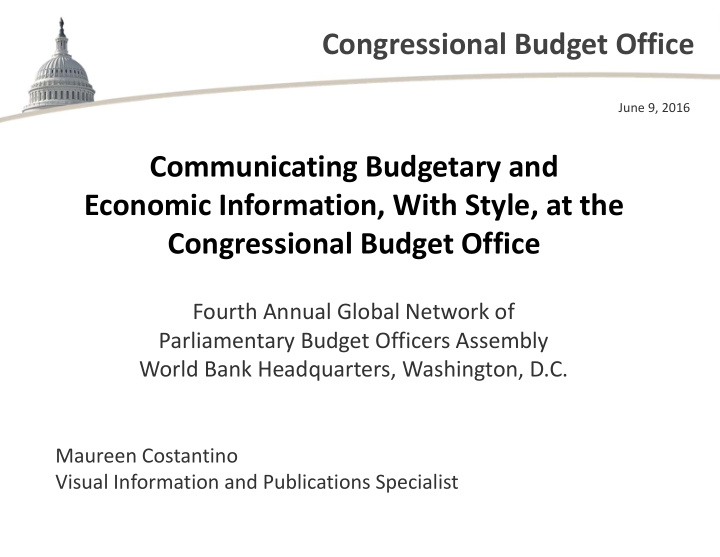



Congressional Budget Office June 9, 2016 Communicating Budgetary and Economic Information, With Style, at the Congressional Budget Office Fourth Annual Global Network of Parliamentary Budget Officers Assembly World Bank Headquarters, Washington, D.C. Maureen Costantino Visual Information and Publications Specialist
What We Are ■ CBO is a United States government agency that was created by the Congressional Budget and Impoundment Control Act of 1974. ■ It provides analysis of budgetary and economic issues that is objective and impartial to the U.S. Congress. The agency is strictly nonpartisan . 1 CONGRESSIONAL BUDGET OFFICE
Who We Are ■ The Director is appointed jointly by the Speaker of the House and President pro tempore of the Senate. ■ CBO has about 235 employees (most with advanced degrees), who are hired solely on the basis of professional competence, without regard to political affiliation. 2 CONGRESSIONAL BUDGET OFFICE
What We Provide to the Congress ■ Baseline budget projections and economic forecasts covering the 10 ‐ year period used in the Congressional budget process ■ Long ‐ term budget projections ■ Cost estimates for legislation, including analyses of federal mandates ■ Scorekeeping for enacted legislation ■ Analysis of the President’s budget (including its likely economic effects and their budgetary feedback) ■ Analytic reports examining specific federal programs, aspects of the tax code, and budgetary and economic challenges 3 CONGRESSIONAL BUDGET OFFICE
Our Projections ■ CBO’s estimates focus on the next 10 years but sometimes look out 20 years or more . ■ They are meant to reflect the middle of the distribution of possible outcomes. 4 CONGRESSIONAL BUDGET OFFICE
What We Do Not Do ■ Make policy recommendations ■ Write legislation ■ Implement programs or regulations ■ Enforce budget rules ■ Evaluate historical performance of government programs 5 CONGRESSIONAL BUDGET OFFICE
Report Production at CBO 6 CONGRESSIONAL BUDGET OFFICE
Publishing Reports at CBO ■ Publishing high ‐ quality content is a demanding job, particularly so because the agency is small. ■ Reports entering production are often on a tight schedule. ■ Accuracy and speed are essential. ■ Products range from stand ‐ alone graphics to full reports. 7 CONGRESSIONAL BUDGET OFFICE
Bird’s Eye View of the Report Process 8 CONGRESSIONAL BUDGET OFFICE
Production Process: The Tools of Our Trade 9 CONGRESSIONAL BUDGET OFFICE
Components of Reports Are Often Repurposed 10 CONGRESSIONAL BUDGET OFFICE
Graphics at CBO 11 CONGRESSIONAL BUDGET OFFICE
Graphics ■ Graphics are created for reports. Many are repurposed to be used in other publications related to the same topic; some stand alone. Sample Snapshot ■ Possible formats: – Website home page announcement of report release; the report landing page – Blog post – Slide deck – Presentation – Infographic – Snapshot – Conference poster 12 CONGRESSIONAL BUDGET OFFICE
An Evolution of Style: Graphs 1998 2003 2010 13 CONGRESSIONAL BUDGET OFFICE
An Evolution of Style: Graphs (Continued) 2012 2016 14 CONGRESSIONAL BUDGET OFFICE
Less Is More 2010 2016 What changed? ■ Gray color for numbers and supporting text ■ Color used meaningfully ■ Lighter gray for recession bars ■ Data plotted annually instead of quarterly when possible ■ Smaller point sizes for titles ■ Upper and right border lines gone ■ No parentheses around units of measure ■ No minor tick marks; shorter, less prominent tick marks ■ All notes (including Source) flush left; the word “Notes” gone ■ Smaller point sizes for type ■ Introduction of captions where useful 15 ■ Gray color for axis lines and Actual/Projected line CONGRESSIONAL BUDGET OFFICE
Fewer Fonts Old Style New Style Helvetica Black Garamond Book Condensed (Bold) Bell Centennial Subcaption Bell Centennial NameandNumber Proxima Nova family used for all graphics and tables, including titles 16 CONGRESSIONAL BUDGET OFFICE
Color Is Key ■ Use of color must have meaning within a report Informal Conventions Blue = spending ■ Colors must map to shades of gray that make Green = revenues elements of a graphic in close proximity easily Purple = debt distinguishable when printed in black and white Orange = anything else 17 CONGRESSIONAL BUDGET OFFICE
Slide Deck: The Budget and Economic Outlook www.cbo.gov/publication/51182 18 CONGRESSIONAL BUDGET OFFICE
Telling the Story With Graphics: Social Security Options www.cbo.gov/publication/51011 19 CONGRESSIONAL BUDGET OFFICE
Judicious Use of Captions: Forecasts of Interest Rates www.cbo.gov/publication/51129 20 CONGRESSIONAL BUDGET OFFICE
Visualizing Complex Topics www.cbo.gov/publication/51182 21 CONGRESSIONAL BUDGET OFFICE
Chartbook: Trends in Joblessness and the Incarceration of Young Men www.cbo.gov/publication/51495 22 CONGRESSIONAL BUDGET OFFICE
Stand ‐ Alone Infographic: The Federal Budget www.cbo.gov/publication/51114 23 CONGRESSIONAL BUDGET OFFICE
Do Judge a Book by Its Cover 24 CONGRESSIONAL BUDGET OFFICE
Who for What? ■ Content specialists ■ Editors ■ Graphic artists ■ Internal and independent reviewers ■ Production specialists ■ Proofreaders ■ Web specialists 25 CONGRESSIONAL BUDGET OFFICE
Bibliography The list below provides links to a few of the people and organizations that have in some way influenced the direction and growth of our graphics initiative: ■ The Economist , http://economist.com ■ The Dallas Morning News Graphics Stylebook, https://knightcenter.utexas.edu/mooc/file/tdmn_graphics.pdf ■ PolicyViz, http://policyviz.com/ ■ The Knight Center, knightcenter.utexas.edu/ ■ Stephen Few, www.perceptualedge.com/ ■ The New York Times , flowingdata.com/tag/new ‐ york ‐ times/ ■ Mark Simonson, www.marksimonson.com/fonts/view/proxima ‐ nova ■ Edward Tufte, www.edwardtufte.com/tufte/ Congressional Budget Office, www.cbo.gov 26 CONGRESSIONAL BUDGET OFFICE
Recommend
More recommend